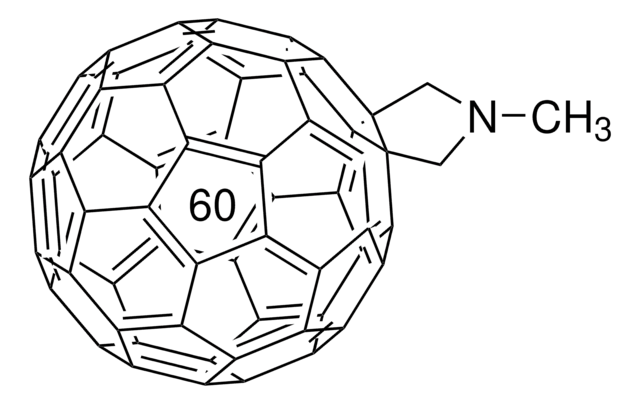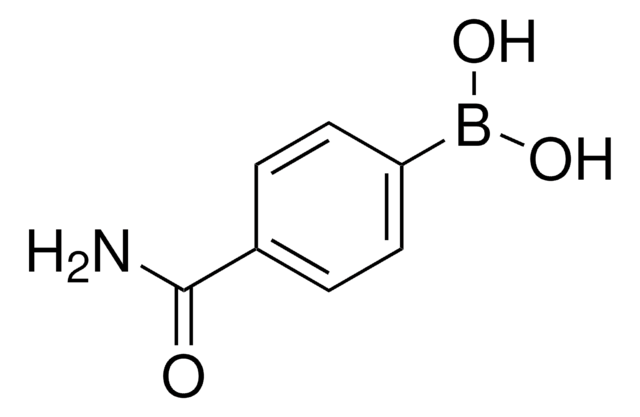684503
[6,6]-Pentadeuterophenyl C61 butyric acid methyl ester
99.5%, 99.5 atom % D
Synonym(s):
1-[3-(Methoxycarbonyl)propyl]-1-pentadeuterophenyl-[6.6] C61, 3′-(Phenyl-d5) 3′H-cyclopropyl[1,9] [5,6]fullerene-C60-Ih-3′-butanoic acid methyl ester, d5-PCBM
About This Item
Recommended Products
description
functionalized fullerene
isotopic purity
99.5 atom % D
Assay
99.5%
form
powder
mass shift
M+5
SMILES string
[2H]c1c([2H])c([2H])c(c([2H])c1[2H])C2(CCCC(=O)OC)[C]3=4c5c6c7c8c9c%10c(c%11c%12c3c%13c5c%14c%15c6c%16c7c%17c9c%18c%19c%10c%20c%11c%21c%12c%22c%13c%23c%14c%24c%15c%25c%16c%26c%17c%18c%27c%28c%19c%20c%29c%21c%30c%22c%23c%31c%24c%32c%25c%26c%27c%33c%28c%29c%30c%31c%32%33)[C]2=48
InChI
1S/C72H14O2/c1-74-11(73)8-5-9-70(10-6-3-2-4-7-10)71-66-58-50-40-30-22-14-12-13-16-20-18(14)26-34-28(20)38-32-24(16)25-17(13)21-19-15(12)23(22)31-37-27(19)35-29(21)39-33(25)43-42(32)52-46(38)56-48(34)54(44(50)36(26)30)62(66)64(56)68-60(52)61-53(43)47(39)57-49(35)55-45(37)51(41(31)40)59(58)67(71)63(55)65(57)69(61)72(68,70)71/h2-4,6-7H,5,8-9H2,1H3/i2D,3D,4D,6D,7D
InChI key
FIGVSQKKPIKBST-QRKCWBMQSA-N
General description
Application
Signal Word
Warning
Hazard Statements
Precautionary Statements
Hazard Classifications
Eye Irrit. 2 - Skin Irrit. 2 - STOT SE 3
Target Organs
Respiratory system
Storage Class Code
11 - Combustible Solids
WGK
WGK 3
Flash Point(F)
Not applicable
Flash Point(C)
Not applicable
Personal Protective Equipment
Choose from one of the most recent versions:
Already Own This Product?
Find documentation for the products that you have recently purchased in the Document Library.
Customers Also Viewed
Articles
Since the first publication in 1995 describing a bulk heterojunction photodiode incorporating a methanofullerene, significant progress has been made in improving device performance and the scope of device research has broadened widely.
Find various photovoltaic and bioscience-based applications of fullerenes.
Single-walled carbon nanotubes (SWCNTs) are promising materials for use in the active channel of field-effect transistors (FETs), photoabsorbing layers of solar cells and photodetectors because of their ultrafast charge transport mobility.
Solution-processed organic photovoltaic devices (OPVs) have emerged as a promising clean energy generating technology due to their ease of fabrication, potential to enable low-cost manufacturing via printing or coating techniques, and ability to be incorporated onto light weight, flexible substrates.
Our team of scientists has experience in all areas of research including Life Science, Material Science, Chemical Synthesis, Chromatography, Analytical and many others.
Contact Technical Service
![[6,6]-Phenyl C61 butyric acid methyl ester ≥99%](/deepweb/assets/sigmaaldrich/product/structures/359/221/d990c746-0960-4c69-bf76-fe09b193824d/640/d990c746-0960-4c69-bf76-fe09b193824d.png)
![4-(1′,5′-Dihydro-1′-methyl-2′H-[5,6]fullereno-C60-Ih-[1,9-c]pyrrol-2′-yl)benzoic acid](/deepweb/assets/sigmaaldrich/product/structures/417/736/540e4dd8-0c87-48e5-8307-3befb16498ba/640/540e4dd8-0c87-48e5-8307-3befb16498ba.png)


![[6,6]-Phenyl C71 butyric acid methyl ester, mixture of isomers 99%](/deepweb/assets/sigmaaldrich/product/structures/716/624/9fb9f2f0-ae99-429f-8d3a-b12267976a4d/640/9fb9f2f0-ae99-429f-8d3a-b12267976a4d.png)
![[6.6] Diphenyl C62 bis(butyric acid methyl ester)(mixture of isomers) 99.5%](/deepweb/assets/sigmaaldrich/product/structures/213/478/93c26667-6556-40bb-8cbe-350bdbabfc00/640/93c26667-6556-40bb-8cbe-350bdbabfc00.png)


